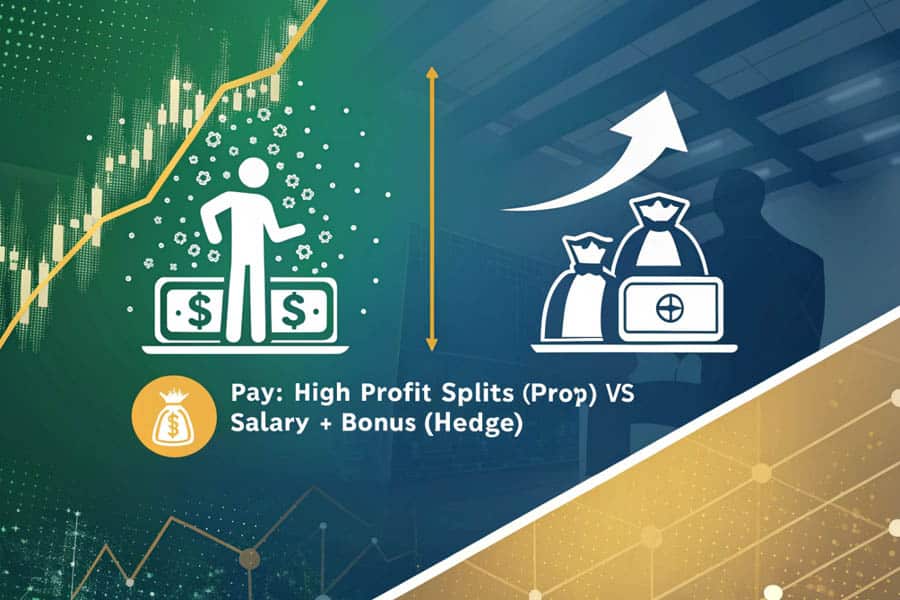Ever feel lost trying to understand the finance world? Terms like “prop firm” and “hedge fund” get tossed around, and while both involve trading and big money, they operate very differently. Maybe you’re mapping out a career, curious about where major financial players operate, or figuring out where a good online forex broker fits in. This uncertainty makes it hard to grasp market roles or career options. This article breaks down the key distinctions in the prop firm vs hedge fund comparison, clarifying everything from their funding sources to how their teams get paid, making the financial world a bit less confusing.

Getting to Know Prop Trading Firms
Proprietary trading firms, or prop firms for short, have a pretty simple game plan: they use their own capital to trade financial markets and turn a profit. Essentially, the firm itself is the client.

Core Idea: Trading the Firm’s Own Money
This is the defining trait of a prop firm. Every trade directly affects the firm’s financial health. They aren’t managing funds for external clients, which means their main responsibility is to the firm’s owners or partners. This internal focus can lead to quicker decisions and potentially more aggressive trading styles compared to firms managing client money.
How They Make Money: Purely Trading Gains
Unlike banks or asset managers with diverse revenue streams, a pure prop firm’s success hinges entirely on its trading performance. Revenue comes directly from the net profits made by buying and selling stocks, bonds, currencies, commodities, and derivatives. Good trading builds capital; bad trading drains it.
Read More: Prop Firm vs Personal Trading Accounts
Different Flavors of Prop Firms
Prop trading isn’t just one thing. You’ll find various setups:
- Independent Shops: These are standalone firms often focusing on specific strategies like high-frequency trading (HFT), statistical arbitrage (finding tiny price differences), or market-making (providing buy/sell quotes). They usually invest heavily in technology.
- Online/Funded Trader Programs: A rapidly growing model where firms give traders capital (often remotely) after they pass a trading challenge. Traders typically split the profits they make, keeping a large percentage. This lowers the entry barrier for individuals needing capital.
- Bank-Related Trading: While regulations like the Volcker Rule have limited this, large banks might still engage in activities similar to prop trading within specific areas like market-making, but under much stricter rules.
- Hedge Fund Internal Desks: Some bigger hedge funds allocate a slice of their own capital (not client money) to pursue proprietary trading strategies separate from their main funds.
The Trader’s Job: Execute and Generate P&L
At a prop firm, a trader’s role is laser-focused: use the firm’s capital to execute trading strategies while strictly following risk rules (like daily loss limits or max position sizes). Success is almost entirely judged by the profit and loss (P&L) generated. It’s a performance-driven environment where results speak volumes.
Common Strategies: Focus on Speed and Tactics
Prop firms often employ strategies designed to capture short-term market opportunities. Think high-frequency trading (HFT), statistical arbitrage, market-making, day trading, swing trading (holding for days/weeks), and various quantitative methods using algorithms and data to find edges.
Understanding Hedge Funds
Hedge funds work differently. Their main business is managing significant amounts of money for external, wealthy investors. The goal is to generate solid returns for these clients, and in return, the fund managers earn fees.

Core Idea: Managing Other People’s Capital
What sets hedge funds apart is their client base. They pool money from sophisticated sources like institutions (pension funds, endowments) and high-net-worth individuals. The fund manager acts as a steward, managing this capital according to a specific investment plan, aiming to deliver returns to these investors.
How They Make Money: The Fee Structure
Hedge funds typically earn revenue through fees charged to investors, often based on the well-known “2 and 20” structure (though fees vary):
- Management Fee: An annual percentage (usually 1-2%) of the total assets under management (AUM). This covers operating costs and is charged regardless of performance.
- Performance (Incentive) Fee: A share (often around 20%) of the profits generated for investors. This usually comes with conditions like exceeding a minimum return (hurdle rate) or surpassing the fund’s previous peak value (high-water mark).
Who Invests: An Exclusive Club
Investing in hedge funds isn’t open to everyone. Due to the complex strategies and risks, investments are typically limited to “accredited investors” (meeting specific wealth/income levels) and large institutional investors. They aren’t available to the average retail investor.
Read More: Forex Trading Career
Common Setup: Partnerships and Complexity
Hedge funds are frequently structured as limited partnerships (LPs). The management company acts as the General Partner (GP), making investment calls, while investors are Limited Partners (LPs), providing the cash. For international operations, complex structures like Master-Feeder funds are often used.
Rules and Regulations: Greater Oversight
Compared to many prop firms, hedge funds operate under stricter regulatory scrutiny (from bodies like the SEC in the US). Regulations focus on protecting investors, ensuring transparency (though still less than mutual funds), preventing fraud, and monitoring potential risks to the financial system, particularly for large funds.
Strategy Spectrum: A Wide Range
Hedge funds utilize a diverse toolkit of investment strategies. These can span everything from long/short equity (betting stocks will go up or down), global macro (trading based on big economic trends), event-driven (profiting from mergers, bankruptcies), distressed debt, and various arbitrage and quantitative strategies. Their investment horizons can range from very short-term to several years.
Prop Firm vs Hedge Fund: The Direct Comparison
Laying them side-by-side really clarifies the core differences in the prop firm vs hedge fund dynamic.

Capital Source: The Fundamental Split
This is the biggest differentiator. Prop firms trade their own cash. Hedge funds trade other people’s money. This single factor influences almost everything else.
Main Goal: Whose Profit Matters Most?
Prop firms want to maximize trading profits for the firm. Hedge funds want to generate strong returns for investors, which allows the manager to earn fees.
Accountability: Internal vs. External Duty
Prop firms answer internally to owners/management. Hedge funds have a legal (fiduciary) duty to their external investors.
Revenue Model: Profit Splits vs. Asset-Based Fees
Prop traders often get paid through profit splits. Hedge fund managers earn management fees (on assets) and performance fees (on investor profits).
Regulatory Load: Lighter Touch vs. Heavier Scrutiny
Standalone prop firms generally face lighter regulations focused on fair market practices. Hedge funds deal with more extensive rules concerning investor protection, reporting, and systemic risk.
Risk Management: Firm’s Tolerance vs. Investor Rules
Prop firms set risk based on their own capital appetite. Hedge funds manage risk according to their investor agreements and fund rules; it’s primarily investor capital on the line.
Getting a Job: Trading Skill vs. Resume & Network
Prop firms, particularly funded programs, might value demonstrated trading skill above all. Hedge funds usually require strong academic credentials, relevant finance experience, and often rely more on networking.
Investor Access: Not Applicable vs. Highly Limited
Prop firms don’t seek outside investors. Hedge funds are exclusive to sophisticated, wealthy investors.
Trading Style: Short-Term Tactics vs. Diverse Approaches
Prop firms often focus on shorter-term, faster-paced trading. Hedge funds use a broad mix of strategies, potentially including much longer investment views. This prop firm vs hedge fund distinction shapes the day-to-day work environment.
Read More: What Is Prop Firm in Forex
Building a Career: Two Different Worlds
Because their business models differ so much, the career paths, necessary skills, and workplace cultures in prop firms and hedge funds are quite distinct.

Typical Roles: Trading Hub vs. Investment Ecosystem
Prop firms tend to be leaner, centered around trading execution (Traders, Quants, Developers, Risk Managers). Hedge funds require a broader setup to handle investments, client relations, and operations (Portfolio Managers, Research Analysts, Execution Traders, Quants, Risk Managers, Investor Relations, Operations, Compliance).
Entry Requirements: Proven Talent vs. Polished Credentials
Prop firms often prioritize provable trading talent (even simulated), strong math/analytical abilities, programming skills, and mental resilience; a stellar resume might be less crucial than demonstrable P&L potential for traders. Hedge funds typically demand top-tier university degrees, often advanced ones for quant roles, previous experience in banking or research, and polished analytical and communication skills.
Career Progression: P&L Ladder vs. Structured Path
Advancement in prop firms (from junior to senior trader, potentially partner) is heavily tied to trading performance. Hedge funds often offer more defined, albeit highly competitive, career tracks (e.g., Analyst to Portfolio Manager), with senior roles potentially earning carried interest (a share of long-term fund profits). Hedge fund experience may open doors to a wider range of finance jobs later.
Work Culture: Intensity & Results vs. Research & Rigor
Prop firms usually feel fast-paced, energetic, and intensely focused on the bottom line (P&L). They can be very meritocratic. Hedge funds are also demanding but might emphasize in-depth research and long-term thesis building more; the atmosphere can feel more formal, and managing investor relationships is part of the job.
Compensation: Prop Trading vs Hedge Fund Salary
Pay structure is a key area where the prop firm vs hedge fund comparison shows major differences, directly reflecting how each makes money. Let’s look closer at the typical prop trading vs hedge fund salary and bonus setup.

Prop Firm Pay: Driven by Profit Splits
Compensation is often directly tied to immediate results. Base salaries can be low or even zero, especially in remote/funded models. The main driver is the profit split: traders keep a large slice (often 50% to 90%+) of the profits they generate. This means huge earning potential based purely on skill, but also high income volatility. A losing month often results in no performance pay. Bonuses, as a separate item, are less common; the split itself functions as the performance incentive.
Hedge Fund Pay: Salary, Bonus, and Carry
Hedge funds generally offer higher and more stable base salaries, providing a safety net. The significant money, especially for senior roles, comes from annual bonuses. These bonuses vary widely based on the fund’s overall success, team performance, and individual contributions, and can be multiples of the base salary. For top partners and portfolio managers, “carried interest” (a share of the fund’s long-term profits) offers the potential for substantial wealth creation over years.
Summing Up Pay: Quick Upside vs. Stable Growth
Prop trading can offer a faster path to high earnings based directly on individual trading skill, appealing if you back your ability to generate P&L consistently. The prop trading vs hedge fund salary gap in base pay is significant. Hedge funds provide more upfront stability and the potential for extremely high total compensation (salary + bonus + carry) at senior levels, but this is linked to overall fund success and usually takes longer to attain.
Weighing the Pros and Cons
Deciding which environment is better depends entirely on your personality, skills, risk tolerance, and what you want out of your career.
Prop Firm Upsides
The direct performance-to-pay link is appealing. Entry might be easier if you have demonstrable skill. High earners can make significant money quickly, focusing solely on trading.
Prop Firm Downsides
It’s a high-stress job with very unpredictable income. Some models involve paying fees. Less job security due to lower/no base pay, and career options might feel narrower later on.
Hedge Fund Upsides
Better base salary provides stability. Potential for exceptionally high earnings at senior levels. Often seen as a more prestigious career path with exposure to diverse, complex strategies and potentially broader exit opportunities in finance.
Hedge Fund Downsides
Entry barriers are extremely high (elite education/experience usually needed). Pay isn’t as directly tied to individual trades for analysts. Intense pressure from investors and performance targets. Success depends heavily on the overall fund’s performance and ability to keep/attract assets.
Explore Your Trading Potential with Opofinance
Whether you’re drawn to the fast-paced world of prop trading or the strategic depth of hedge funds, having the right broker is essential. Opofinance, regulated by ASIC, offers a powerful platform and innovative tools designed for serious traders.
- Advanced Trading Platforms: Access markets your way with popular choices like MT4, MT5, cTrader, and the user-friendly OpoTrade platform.
- Innovative AI Tools: Gain an edge with AI-driven insights from the AI Market Analyzer, personalized guidance from the AI Coach, and responsive AI Support.
- Diverse Trading Options: Explore opportunities beyond traditional trading with integrated Social Trading and Prop Trading programs.
- Secure & Flexible Transactions: Benefit from safe, convenient deposit and withdrawal options, including crypto payments, with zero transaction fees charged by Opofinance.

Ready to trade with advanced technology and the security of a regulated broker?
Conclusion: Finding Your Fit
So, who wins in the prop firm vs hedge fund debate? There’s no single winner, only different approaches. Prop firms bet their own capital for direct profit, often paying traders based on performance splits. Hedge funds manage client money, earning fees based on assets and returns, offering more structured roles and compensation. The best choice depends on your personality, skills, and career ambitions. Understanding the fundamental prop firm vs hedge fund difference – whose money is being traded – is the first step to finding your place in the financial world.
Key Takeaways
- Core Difference: Prop firms trade own funds; Hedge funds trade client funds.
- Main Goal: Prop firms seek profit for the firm; Hedge funds seek returns for clients (to earn fees).
- Revenue Source: Prop firms = trading profits (traders get profit share); Hedge funds = management/performance fees.
- Regulation: Generally heavier for hedge funds (investor protection focus).
- Pay Structure: Prop = direct profit split (volatile, high upside); Hedge Fund = Salary + Bonus + Carry (more stable base, huge long-term potential). See prop trading vs hedge fund salary.
- Entry: Prop may prioritize skill; Hedge funds often require strong credentials/experience.
Can you switch from a hedge fund analyst role to prop trading?
Yes, this switch is definitely possible and perhaps more common than the other way around for certain roles. An analyst leaving a hedge fund likely possesses strong analytical skills, market knowledge, and financial modeling abilities. If they also have a good sense of market timing and risk management, or develop strong technical trading skills, they could transition well into a discretionary or even quantitative prop trading role. Prop firms value individuals who can generate P&L, regardless of their background, provided they can prove their capabilities, often through simulation or a trial period.
Do prop firms or hedge funds offer better work-life balance?
Neither is typically known for great work-life balance, especially compared to careers outside high finance. Both demand long hours, intense focus, and high performance. However, there can be subtle differences. Some argue prop trading, particularly day trading or HFT, might have intense hours during market operation but potentially less “homework” (like deep fundamental research) required after hours compared to a hedge fund analyst preparing investment theses. Conversely, hedge fund roles might offer slightly more predictable schedules outside of major market events or reporting periods, whereas a prop trader’s P&L pressure is constant when markets are open. Ultimately, it varies hugely by firm culture, strategy, and individual role.
Are ethical considerations different between the two?
Both operate under strict regulations regarding market manipulation, insider trading, and fair practices. However, hedge funds have an added layer of ethical responsibility: the fiduciary duty to act in the best interests of their external investors. This includes fair fee structures, transparent reporting (within regulatory limits), managing conflicts of interest appropriately, and ensuring investment suitability. While prop firms must trade fairly, their primary ethical obligation is to the firm’s capital and owners, not an external client base, which simplifies certain ethical considerations but doesn’t eliminate the need for market integrity.







